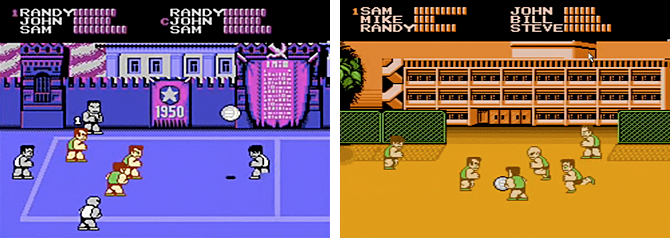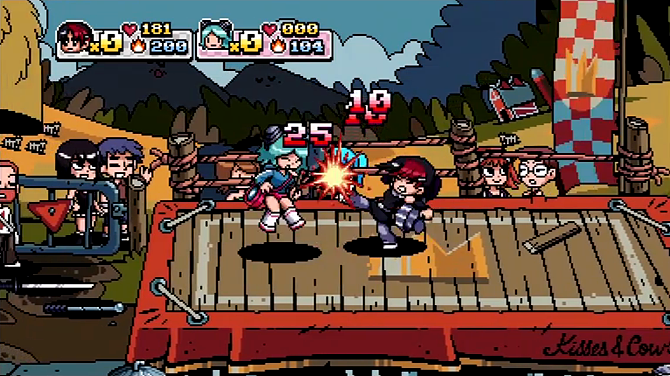Scott Pilgrim Vs. The World: Knives Chau Add-On Pack

Publisher: Ubisoft Entertainment / Developer: Ubisoft Montreal Studios / Platform: XBLA, PSN
Released first on PSN and then XBLA a month later, the Knives Chau Add-On Pack DLC adds one more playable character to the game, plus three new achievements/trophies. It also includes a subtle modification to “Average Joe” (or “easy”) difficulty that makes the enemies a little more forgiving.
And really, they could’ve just left it at that, and those of us who are completists would’ve bought it just to have a complete set of playable characters, and the rest of the achievements. But as a bonus, two new game modes paying tribute to a couple classic old games were also included.
Unfortunately, the modes end up sharing more in common with tacked-on B-Modes from games in the NES days, than the actual games being paid tribute to, and the result is a little disappointing.
Dodge Ball
While most people think of the game Scott Pilgrim Vs. The World as being a tribute to classic beat-em ups scattered with references to classic games, it could be more accurately described as a love letter to defunct developer Technos, with references to other classic games mixed in.
In particular, the core framework of the game — a Beat ‘Em Up where enemies leave change behind, and items can be bought from stores to increase your character’s stats — is based on Technos’ River City Ransom, a game for the NES that was initially lost in the shuffle upon release, but over time developed a cult following.
The two new game modes continue this trend. Dodge Ball mode (pictured above) is a tribute to Technos’ Super Dodgeball for the NES. In the main Tournament Mode, you were in control of a team of players progressing through a dodgeball tournament. Many fans of old Technos games were hoping this is what the DLC’s Dodge Ball would end up being, but instead the mode was based more on Super Dodgeball’s Bean Ball mode.

Left: After defeating the final team in Tournament Mode, your team must face off against shadow versions of themselves. Sound familiar? Right: Bean Ball mode.
Like Bean Ball mode, Dodge Ball mode is a free-for-all. No teams, one ball, last person standing wins. I can only assume you fight against a bunch of Richards due to their being the variety of thug that most closely resembles a Technos character (Billy of Double Dragon). Your first instinct might be to try and punch and kick the other players, but damage can only be done to them via the ball. Once you’ve taken everyone out, the game ends and you return to the main menu, just like the old Bean Ball mode. As you can imagine, replay value is a little limited.
It might’ve been fun as a short occasional diversion, particularly with a group of friends, but unfortunately the ball mechanics don’t work as smoothly as in the original game. In particular, half the time you spend trying to pick up the ball, you will instead end up punching it. Eventually you give up and realize its more efficient to just punch or kick the ball into an opposing player, which still does damage. Picking up the ball and using it as a melee weapon does not work, however.
You’ll probably play this mode once (possibly twice), and then never come back to it again.
Battle Royal

Battle Royal mode is a little more subtle in what it’s paying tribute to. In 1991, Technos released an arcade called WWF WrestleFest. This was actually their second WWF arcade, but this one included two play modes: “Saturday Night’s Main Event” Tag Team, and the new “Royal Rumble” Battle Royal. It was also possibly the first wrestling game to allow you to grab items while outside of the ring, to hit people with.

Right: The Million Dollar Man gets ready to throw a metal case at someone.
However, in the arcade’s “Royal Rumble” mode, six wrestlers (up to four of them playable at once) were put in a ring to battle it out in a free-for-all. Ending up outside of the ring would result in instant disqualification, so there were no weapons in this mode. In “Saturday Night’s Main Event,” you were allowed to be outside of the ring, but only for the count of 20.
The DLC’s Battle Royal ends up being a strange hybrid of the two. It’s a free-for-all with up to four players, yet you can also leave the ring — for up to 10 seconds, which I think is entirely reasonable — to go grab weapons to use.
Unfortunately, there are no CPU players in this mode, so the only way you can play is if you have other people who want to play, and there’s no way to have six characters fighting at once. Which is disappointing, since how fun this mode ends up being is largely dependent on how many people are in the battle.
I’m also a little disappointed at the lack of ropes to bounce against or jump off of, but what can you do?
The worst part about the two new modes is that if they hadn’t been included at all, the DLC would’ve come across as just a character add-on with achievements, which accomplished exactly what it set out to do. Yet by adding these two new bonus modes, which hint at potential of something that could’ve been greater, the result ends up feeling more disappointing than like a bonus. Though, they do kind of accurately capture the spirit of crappy B-Modes from the NES days. Maybe if they’d have advertised it as “plus two crappy B-Modes, just like the old days!,” I would’ve laughed along while playing and enjoyed the modes more.
But it’s particularly frustrating when a lot of us would rather the time had been spent working on adding online play. Hell, I might’ve paid more for the DLC if it had included a patch for online play.
However, despite my complaints, it does fully deliver on its promise of being a character add-on pack, with additional achievements. And for that reason, I give this DLC a:

















November 9, 2011
I wish I read this before I bought the DLC. Despite the fact that it was cheap and that I gained an extra character, I still feel it’s a ripoff because I think the developer was deliberately misleading. The main reason I bought this was because I thought I would be getting a Super Dodgeball-type game, and I think the developer was banking on the fact that most people would think that. Not only that, but at least Bean Ball mode in the original game was fun. I also think that most people would assume that the Battle Royal would be a lot less lame than it is, as well. I don’t know about other people, but the two “bonus” modes are worthless to me, and the whole experience has soured me on what was otherwise a great game.